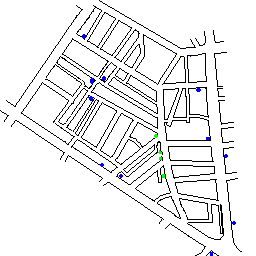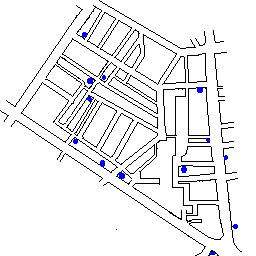The Kite area of Cambridge
The Kite is bounded by East Road, Newmarket Road, Maids Causeway,
Short Street, Emmanuel Road, Parker Street and Parkside
- see the maps below.
The area has a distinctive character, though much muted since the
Grosvenor Developments construction of the Grafton Centre in 1981-1983.
This ripped the community heart out of the area and destroyed
a lot of terrace housing, shops and popular meeting places.
Belatedly, the City Council is trying to restore the area with the
help of English Heritage - much of it is a conservation area.
Steps to Redevelopment
The history of the redevelopment is closely tied to
the Lion Yard development
and The Holford Report of 1950.
This was the start of the planning blight in the area.
In 1959 Cambridge University proposed that the whole of the Kite become a
regional shopping centre with parking for 10,000 cars, as an alternative to
developing the City centre for shopping. By 1962 the University was proposing a
smaller redevelopment of the Kite and that the Lion Yard area be for civic
facilities, such as a library and arts centre. The City Council broadly agreed
to this in 1966.
Jesus College (a major landowner in the Kite), the
City Council and Samuel Properties produced detailed proposals in 1971.
Some of the major buildings such as the
Burleigh St. Co-Op and
Laurie and McConnal's would be retained
but Fitzroy Street would be covered by a translucent covering as a pedestrian route.
A restaurant was suggested at the Fitzroy Street/Burleigh St. junction
[where the Eden Baptist Chapel still exists as Footlights restaurant].
The famous architects Piano & Rogers [Pompidou Centre...] drew up plans which were adopted
by the City and County Councils. They were considered at a Public Enquiry in 1973 and approved.
Around this time (early 1970s) the City Council swung from Labour to Conservative control,
due partly to the student vote.
Kite Community Action was formed to fight this scheme: a small but extremely effective pressure group who generated
a lot of high-profile publicity. They chose the Little Kettle cafe as HQ.
The Parry Report of 1973, studying the sub-region around the City, concluded
that a new major centre should be developed around Trumpington, to match the
existing City within 20 years, but that this would only be viable if the Kite
development did not go ahead.
The City and County rejected the idea due to cost.
The developers backed out due to lack of finance and cost also led the City
Council to reject the 1971 plans in 1976.
The scheme was shelved for a while...
Meanwhile many people had been moved out of the area to the new suburb of Arbury since the 1950s
and the Council was now finding that the lack of facilities in Arbury was a major problem.
[A Community Centre was at last built in 1974 and the Arbury Court shops in 1976.]
The situation in 1976-1980
Whilst the Victorian terrace houses of the Fitzroy St./Burleigh St. area were
indeed relatively run-down, leading to the tag as "slums", and the shops
generally small compared to modern needs, all those problems could have been
fixed by a gradual process of sympathetic renewal.
But for the planning blight of 30 years of indecision, this probably would have happened.
As things were, landlords and retailers were not prepared to invest:
blight made repairing property uneconomic and once empty, properties were demolished.
Buildings in Gold St. near Waffles were gone by 1974.
Against the trend, The Free Press was refurbished, reopening in 1978.
![[Habitat]](pics/habitat.jpg) Laurie & McConnal's in Fitzroy St. closed in 1977 due to the planning blight.
The original 1883 store had burnt down 1903, to be replaced
by the distinctive building with a bandstand in the roof.
The building was sympathetically restored by Habitat in 1982-3.
Laurie & McConnal's in Fitzroy St. closed in 1977 due to the planning blight.
The original 1883 store had burnt down 1903, to be replaced
by the distinctive building with a bandstand in the roof.
The building was sympathetically restored by Habitat in 1982-3.
Short-term leases allowed small shops to set up in Kite and
provided cheap accomodation for
Tech students.
There were still many pensioners living in the houses in which they were born.
This may have led to the redevelopment of the Prospect Row area around the mid-70s as warden-controlled accommodation.
Generally the western and northern side, outside the main blighted area, is unspoiled.
The Council reached agreement with Grosvenor Developments in 1978.
Memories from 1980/81
By 1980 there were ugly tracts of bulldozed land, some seemingly semi-permanent by then.
The City Council (it was said) had to proceed with the redevelopment in spite of the intense
campaigning and protests by City residents, as it had signed a binding agreement with Grosvenor Developments. The Conservative
leader of the Council,
John Powley, pushed through the scheme.
Pat & Virginia from Waffles plus their Kite Community Action friends were very active,
trying to find new ways of preventing or delaying the development and in particular at least one
sympathetic Don at Jesus College tried to stop the scheme.
There was a real determination to avoid a second Petty Cury/Lion Yard abomination.
There were even benefit concerts with the likes of Clive James, Michael Palin & Terry Jones.
However in late 1980/early 1981 most of Gold Street and eastern Fitzroy Street was demolished.
Waffles and some businesses in western Fitzroy Street held out,
Waffles finally closing on 30th Oct. 1981 [as I recall].
At the time all this seemed very long drawn out though it was
nothing compared to the 30 years of wrangling.
In 1994/1995 the Grafton Centre Extension was built and as of 1997 the Centre is
owned by the Prudential.
North-->


Hand-drawn sketch maps - reasonably accurate.
See also streets on the 1980 map.
Some of the much-missed features
- The quiet streets of terraced housing
(though the County Council would probably have installed
Traffic Calming by now)
- Waffles Cafe
- Potter Products
- Strudels Restaurant
- About 4 doors further down Fitzroy Street from Waffles
- The Ancient Druids
- ? next door to the restaurant
- Very Irish - a real community pub
(nothing like its replacement).
Mary the landlady went on to The Geldart and then the Man On the Moon.
Not missed
- New Square
![[New Square]](pics/newsq1.jpg)
- .. as a cement-surfaced car park, with an ugly foot-bridge for the pedestrian route
towards Christ's Pieces where it crossed over the slightly-sunken main lane of the car park.
It had been converted from rough pasture in 1932-4.
Footnotes
became MP for Norwich South between 1983-87
and in 1997 returned to politics as the county councillor for Soham. He then
became Chairman of the Social Services Committee from April 1998.
If I remember correctly, this was Dr Lisa Jardine, now [c2000]
Professor of Renaissance Studies at Queen Mary and Westfield College, London.
Reference
The Varsity Handbook 1976/77, Town section.
Cambridge
: History
: The Kite - Early History
![[Habitat]](pics/habitat.jpg) Laurie & McConnal's in Fitzroy St. closed in 1977 due to the planning blight.
The original 1883 store had burnt down 1903, to be replaced
by the distinctive building with a bandstand in the roof.
The building was sympathetically restored by Habitat in 1982-3.
Laurie & McConnal's in Fitzroy St. closed in 1977 due to the planning blight.
The original 1883 store had burnt down 1903, to be replaced
by the distinctive building with a bandstand in the roof.
The building was sympathetically restored by Habitat in 1982-3.


![[New Square]](pics/newsq1.jpg)